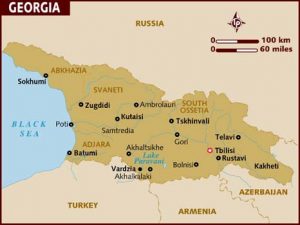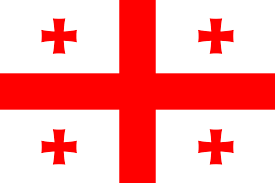Population: 10,52 million (2018)
Area: 153 910 km²
Georgia covers a territory of 69,700 square kilometres (26,911 sq mi), and its 2017 population is about 3.718 million. Georgia is a unitary semi-presidential republic, with the government elected through a representative democracy.
During the classical era, several independent kingdoms became established in what is now Georgia, such as Colchis and Iberia. The Georgians adopted Christianity in the early 4th century. The common belief had an enormous importance for spiritual and political unification of early Georgian states. A unified Kingdom of Georgia reached its Golden Age during the reign of King David IV and Queen Tamar in the 12th and early 13th centuries. Thereafter, the kingdom declined and eventually disintegrated under hegemony of various regional powers, including the Mongols, the Ottoman Empire, and successive dynasties of Iran. In the late 18th century, the eastern Georgian Kingdom of Kartli-Kakheti forged an alliance with the Russian Empire, which directly annexed the kingdom in 1801 and conquered the western Kingdom of Imereti in 1810.
Currency
The Georgian Lari is the currency of Georgia. Our currency rankings show that the most popular Georgia Lari exchange rate is the USD to GEL rate. The currency code for Lari is GEL. Below, you'll find Georgian Lari rates and a currency converter.
Climate

Much of western Georgia lies within the northern periphery of the humid subtropical zone with annual precipitation ranging from 1,000–4,000 mm (39.4–157.5 in). The precipitation tends to be uniformly distributed throughout the year, although the rainfall can be particularly heavy during the Autumn months. The climate of the region varies significantly with elevation and while much of the lowland areas of western Georgia are relatively warm throughout the year, the foothills and mountainous areas (including both the Greater and Lesser Caucasus Mountains) experience cool, wet summers and snowy winters (snow cover often exceeds 2 meters in many regions). Ajaria is the wettest region of the Caucasus, where the Mt. Mtirala rainforest, east of Kobuleti, receives around 4,500 mm (177.2 in) of precipitation per year.
Eastern Georgia has a transitional climate from humid subtropical to continental. The region's weather patterns are influenced both by dry Caspian air masses from the east and humid Black Sea air masses from the west. The penetration of humid air masses from the Black Sea is often blocked by mountain ranges (Likhi and Meskheti) that separate the eastern and western parts of the nation. Annual precipitation is considerably less than that of western Georgia and ranges from 400–1,600 mm (15.7–63.0 in).
The wettest periods generally occur during spring and autumn, while winter and summer months tend to be the driest. Much of eastern Georgia experiences hot summers (especially in the low-lying areas) and relatively cold winters. As in the western parts of the nation, elevation plays an important role in eastern Georgia where climatic conditions above 1,500 metres (4,921 ft) are considerably colder than in the low-lying areas. The regions that lie above 2,000 metres (6,562 ft) frequently experience frost even during the summer months.
Language
Georgian is a Kartvelian language spoken by Georgians. It is the official language of Georgia. Georgian is written in its own writing system, the Georgian script. Georgian is the literary language for all regional subgroups of Georgians, including those who speak other Kartvelian languages: Svans, Mingrelians and the Laz.
Georgian is the most pervasive of the Kartvelian languages, a family that also includes Svan and Megrelian (chiefly spoken in Northwest Georgia) and Laz (chiefly spoken along the Black Sea coast of Turkey, from Melyat, Rize, to the Georgian frontier).
Economy
Archaeological research demonstrates that Georgia has been involved in commerce with many lands and empires since ancient times, largely due its location on the Black Sea and later on the historical Silk Road. Gold, silver, copper and iron have been mined in the Caucasus Mountains. Georgian wine making is a very old tradition and a key branch of the country's economy. The country has sizable hydropower resources. Throughout Georgia's modern history agriculture and tourism have been principal economic sectors, because of the country's climate and topography.
For much of the 20th century, Georgia's economy was within the Soviet model of command economy. Since the fall of the USSR in 1991, Georgia embarked on a major structural reform designed to transition to a free market economy. As with all other post-Soviet states, Georgia faced a severe economic collapse. The civil war and military conflicts in South Ossetia and Abkhazia aggravated the crisis. The agriculture and industry output diminished. By 1994 the gross domestic product had shrunk to a quarter of that of 1989. The first financial help from the West came in 1995, when the World Bank and International Monetary Fund granted Georgia a credit of US$206 million and Germany granted DM 50 million.
Since the early 21st century visible positive developments have been observed in the economy of Georgia. In 2007, Georgia's real GDP growth rate reached 12 percent, making Georgia one of the fastest-growing economies in Eastern Europe. The World Bank dubbed Georgia "the number one economic reformer in the world" because it has in one year improved from rank 112th to 18th in terms of ease of doing business. Georgia improved its position to 6th in World Bank's Doing Business report 2019. The country has a high unemployment rate of 12.6{3c1c73b8ea441ddf8a4d663eab0e2160356a1ef000f6736f4da63eb678683415} and has fairly low median income compared to European countries.
The 2006 ban on imports of Georgian wine to Russia, one of Georgia's biggest trading partners, and break of financial links was described by the IMF Mission as an "external shock".In addition, Russia increased the price of gas for Georgia. Around the same time, the National Bank of Georgia stated that ongoing inflation in the country was mainly triggered by external reasons, including Russia's economic embargo. The Georgian authorities expected that the current account deficit due to the embargo in 2007 would be financed by "higher foreign exchange proceeds generated by the large inflow of foreign direct investment" and an increase in tourist revenues. The country has also maintained a solid credit in international market securities. Georgia is becoming more integrated into the global trading network: its 2015 imports and exports account for 50% and 21% of GDP respectively Georgia's main imports are fuels, vehicles, machinery and parts, grain and other foods, pharmaceuticals. Main exports are vehicles, ferro-alloys, fertilizers, nuts, scrap metal, gold, copper ores.Georgia is developing into an international transport corridor through Batumi and Poti ports, Baku–Tbilisi–Kars Railway line, an oil pipeline from Baku through Tbilisi to Ceyhan, the Baku–Tbilisi–Ceyhan pipeline (BTC) and a parallel gas pipeline, the South Caucasus Pipeline
Education
The education system of Georgia has undergone sweeping modernizing, although controversial, reforms since 2004. Education in Georgia is mandatory for all children aged 6–14. The school system is divided into elementary (six years; age level 6–12), basic (three years; age level 12–15), and secondary (three years; age level 15–18), or alternatively vocational studies (two years). Students with a secondary school certificate have access to higher education. Only the students who have passed the Unified National Examinations may enroll in a state-accredited higher education institution, based on ranking of the scores received at the exams.
Most of these institutions offer three levels of study: a Bachelor's Program (three to four years); a Master's Program (two years), and a Doctoral Program (three years). There is also a Certified Specialist's Program that represents a single-level higher education program lasting from three to six years. As of 2016, 75 higher education institutions are accredited by the Ministry of Education and Science of Georgia. Gross primary enrollment ratio was 117 percent for the period of 2012–2014, the 2nd highest in Europe after Sweden.
Tbilisi has become the main artery of the Georgian educational system, particularly since the creation of the First Georgian Republic in 1918 permitted the establishment of modern, Georgian-language educational institutions. Tbilisi is the home to several major institutions of higher education in Georgia, notably the Tbilisi State Medical University, which was founded as Tbilisi Medical Institute in 1918, and the Tbilisi State University (TSU), which was established in 1918 and remains the oldest university in the entire Caucasus region. With enrollment of over 35,000 students, the number of faculty and staff (collaborators) at TSU is approximately 5,000. Georgia's main and largest technical university, Georgian Technical University, as well as The University of Georgia (Tbilisi),Caucasus University and Free University of Tbilisi are also in Tbilisi.
Religion
Today 83.4 percent of the population practices Eastern Orthodox Christianity, with the majority of these adhering to the national Georgian Orthodox Church. The Georgian Orthodox Church is one of the world's most ancient Christian Churches, and claims apostolic foundation by Saint Andrew.[238] In the first half of the 4th century, Christianity was adopted as the state religion of Iberia (present-day Kartli, or eastern Georgia), following the missionary work of Saint Nino of Cappadocia. The Church gained autocephaly during the early Middle Ages; it was abolished during the Russian domination of the country, restored in 1917 and fully recognised by the Ecumenical Patriarchate of Constantinople in 1989.
The special status of the Georgian Orthodox Church is officially recognised in the Constitution of Georgia and the Concordat of 2002, although religious institutions are separate from the state, and every citizen has the right of religion.
Religious minorities of Georgia include Muslims (10.7 percent), Armenian Christians (2.9 percent) and Roman Catholics (0.5 percent). 0.7 percent of those recorded in the 2014 census declared themselves to be adherents of other religions, 1.2 percent refused or did not state their religion and 0.5 percent declared no religion at all.
Islam is represented by both Azerbaijani Shia Muslims (in the south-east) ethnic Georgian Sunni Muslims in Adjara, and Laz-speaking Sunni Muslims as well as Sunni Meskhetian Turks along the border with Turkey. In Abkhazia, a minority of the Abkhaz population is also Sunni Muslim, alongside the faithful of the revived Abkhaz pagan faith. There are also smaller communities of Greek Muslims (of Pontic Greek origin) and Armenian Muslims, both of whom are descended from Ottoman-era converts to Turkish Islam from Eastern Anatolia who settled in Georgia following the Lala Mustafa Pasha's Caucasian campaign that led to the Ottoman conquest of the country in 1578. Georgian Jews trace the history of their community to the 6th century BC; their numbers have dwindled in the last decades due to high levels of immigration to Israel.
Despite the long history of religious harmony in Georgia, there have been instances of religious discrimination and violence against "nontraditional faiths", such as Jehovah's Witnesses, by followers of the defrocked Orthodox priest Basil Mkalavishvili.
In addition to traditional religious organizations, Georgia retains secular and irreligious segments of society (0.5 percent), as well as a significant portion of religiously affiliated individuals who do not actively practice their faith.
Despite that Georgian major population are Orthodox Christians and some minor discrimination against people with different faith, country is very tolerant to other religions. For example, Tbilisi's Leselidze Street on has a church, mosque, and synagogue next to each other.
Culture
Georgian culture evolved over thousands of years from its foundations in the Iberian and Colchian civilizations. Georgian culture enjoyed a renaissance and golden age of classical literature, arts, philosophy, architecture and science in the 11th century. Georgian culture was influenced by Classical Greece, the Roman Empire, the Byzantine Empire, the various Iranian empires (notably the Achaemenid, Parthian, Sassanian, Safavidand Qajar empires), and later, from the 19th century, by the Russian Empire.
The Georgian language, and the Classical Georgian literature of the poet Shota Rustaveli, were revived in the 19th century after a long period of turmoil, laying the foundations of the romantics and novelists of the modern era such as Grigol Orbeliani, Nikoloz Baratashvili, Ilia Chavchavadze, Akaki Tsereteli, Vazha-Pshavela. The Georgian language is written in three unique scripts, which according to traditional accounts were invented by King Pharnavaz I of Iberia in the 3rd century BC.
Georgia is known for its folklore, traditional music, dances, theatre, cinema, and art. Notable painters from the 20th century include Niko Pirosmani, Lado Gudiashvili, Elene Akhvlediani; notable ballet choreographers include George Balanchine, Vakhtang Chabukiani, and Nino Ananiashvili; notable poets include Galaktion Tabidze, Lado Asatiani, and Mukhran Machavariani; and notable theatre and film directors include Robert Sturua, Tengiz Abuladze, Giorgi Danelia and Otar Ioseliani.
Health
Healthcare in Georgia is provided by a universal health care system under which the state funds medical treatment in a mainly privatized system of medical facilities. In 2013, the enactment of a universal health care program triggered universal coverage of government-sponsored medical care of the population and improving access to health care services. Responsibility for purchasing publicly financed health services lies with the Social Service Agency (SSA).
From 1921 to 1991, the Georgian health system was part of the Soviet system. Till 1995 health care system in Georgia was based on Soviet Semashko model. The first dramatic change was implemented in 1995, when the budget transfers were complemented with additional sources of the financing: the mandatory health insurance contributions (employer and the employee mandatory contribution - 3%and 1% respectively), funds allocated for Healthcare from the territorial budgets, official co-payment for medical services, which could not be financed by the state programs. Mandatory social health insurance was abolished after the 2003-2004 Rose Revolution. In 2003, the social insurance tax was replaced by social tax, which was accumulated in the state budget and from 2007 the GoG decided to delegate management of state allocations for health insurance for targeted groups of population (the poor, teachers, law enforcement officers and military personnel (or about 40% of the population), to the private insurance companies, which have become the health service purchaser for the mentioned population groups. This meant that a portion of the population could not access health insurance. The state retained control over a few medical facilities dealing with mental illness and infectious diseases, while all other hospitals and clinics were privatized. Implementation of universal healthcare was a key priority of the Georgian Dream party, which came to power in the 2012 election. It established the current Georgian healthcare system from 2013.Since 2013, there has been a radical change of direction in health financing policy as a new government embraced the move towards universal health coverage rather than targeted benefits.In 2016 average life expectancy for Georgians is 72.7, which lies just below the European average of about 78 years (2014). The life expectancy in Georgia is 68.2 for males, and 77.1 for females.
In 2016 the total fertility rate is 2.24 children per woman. Live birth rate is 15.2 per 1000, and mortality rate is 13.7 per 1000. In 2016 infant mortality rate was 9.0 per 1000 live births, and the under-5 mortality rate was 10.7. By 2030, the Maternal mortality rate is expected to drop to 12, and the under-5 mortality rate is expected to drop to 6.0. Maternal mortality is 23.0 per 100,000 live births in 2016.While still high in international comparison, maternal and infant mortality rates have been steadily decreasing.
In Georgia, as in the most countries, mortality burden is mostly due to non-communicable diseases. The major causes of death are diseases of the circulatory system, neoplasms, diseases of respiratory system and accidents and injuries. The leading position in the structure of morbidity is associated with Diseases of the respiratory organs, digestive system and circulation system. Infectious diseases are still the source of significant health problems, especially MDR tuberculosis.
Transportation
Today transport in Georgia is provided by rail, road, ferry, and air. Total length of roads excluding occupied territories is 20,553 kilometers and railways – 1,576 km. Positioned in the Caucasus and on the coast of the Black Sea, Georgia is a key country through which energy imports to the European Union from neighbouring Azerbaijan pass. Traditionally, the country was located on an important north-south trade route between European Russia and the Near East and Turkey.In recent years Georgia has invested large amounts of money in the modernization of its transport networks. The construction of new highways has been prioritized and, as such, major cities like Tbilisi have seen the quality of their roads improve dramatically; despite this however, the quality of inter-city routes remains poor and to date only one motorway-standard road has been constructed.
The Georgian railways represent an important transport artery for the Caucasus, as they make up the largest proportion of a route linking the Black and Caspian Seas. In turn, this has allowed them to benefit in recent years from increased energy exports from neighbouring Azerbaijan to the European Union, Ukraine, and Turkey. Passenger services are operated by the state-owned Georgian Railways whilst freight operations are carried out by a number of licensed operators. Since 2004 the Georgian Railways have been undergoing a rolling program of fleet-renewal and managerial restructuring which is aimed at making the service provided more efficient and comfortable for passengers. Infrastructural development has also been high on the agenda for the railways, with the key Tbilisi railway junction expected to undergo major reorganisation in the near future. Additional projects also include the construction of the economically important Kars–Tbilisi–Baku railway, which was opened on October the 30th, 2017 and connects much of the Caucasus with Turkey by standard gauge railway.
Air and maritime transport is developing in Georgia, with the former mainly used by passengers and the latter for transport of freight. Georgia currently has four international airports, the largest of which is by far Tbilisi International Airport, hub for Georgian Airways, which offers connections to many large European cities. Other airports in the country are largely underdeveloped or lack scheduled traffic, although, as of late, efforts have been made to solve both these problems. There are a number of seaports along Georgia's Black Sea coast, the largest and most busy of which is the Port of Batumi; whilst the town is itself a seaside resort, the port is a major cargo terminal in the Caucasus and is often used by neighbouring Azerbaijan as a transit point for making energy deliveries to Europe. Scheduled and chartered passenger ferry services link Georgia with Bulgaria, Romania, Turkey and Ukraine.
Cuisine
Georgian cuisine and wine have evolved through the centuries, adapting traditions in each era. One of the most unusual traditions of dining is supra, or Georgian table, which is also a way of socialising with friends and family. The head of supra is known as tamada. He also conducts the highly philosophical toasts, and makes sure that everyone is enjoying themselves. Various historical regions of Georgia are known for their particular dishes: for example, khinkali (meat dumplings), from eastern mountainous Georgia, and khachapuri, mainly from Imereti, Samegrelo and Adjara. In addition to traditional Georgian dishes, the foods of other countries have been brought to Georgia by immigrants from Russia, Greece, and recently China....














